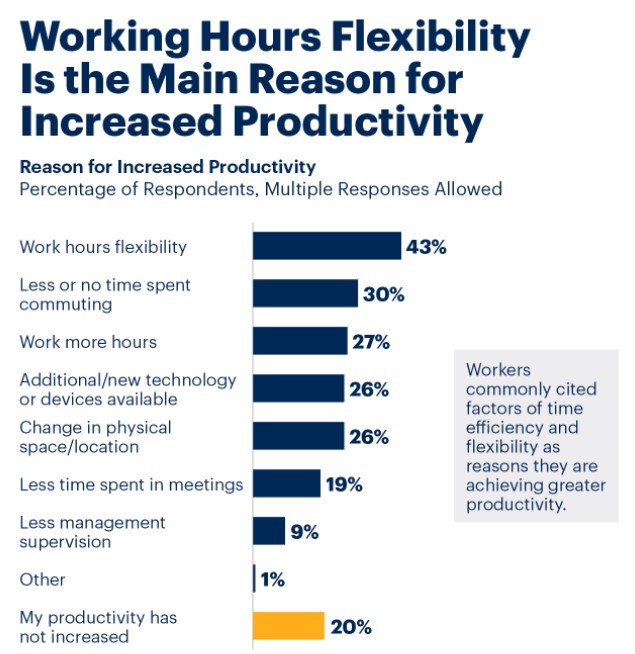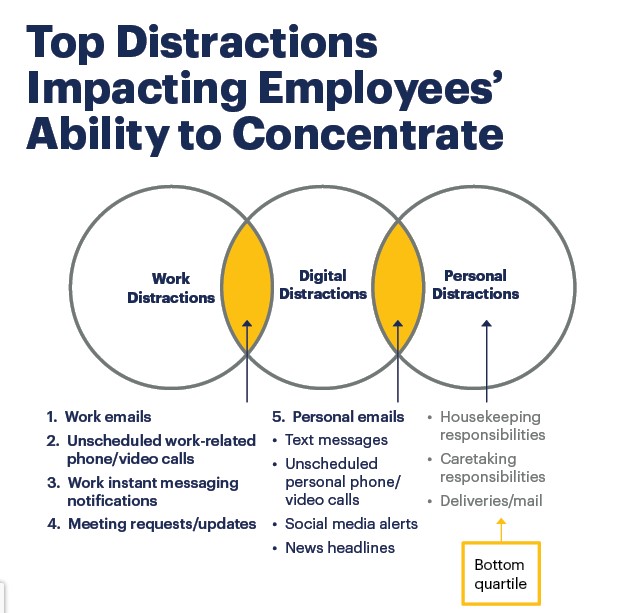Much ink has been spilled on the pitfalls of digital distraction. The never-ending supply of meaningless diversions can wreak havoc on your workflow. The cunning forces of the attention economy and a global industry dedicated to luring your staff away from their most valuable work or commitments can test whether we have enough willpower to resist.
In the face of such forces, willpower on its own is increasingly inadequate. Stringing together enough time for deep concentration is getting harder by the day.
Yet, this framing also ignores a vital truth about distraction. When we give in to the temptation to check our emails, it’s still our choice to cave. All the more reason to set boundaries to salvage our time!
Fortunately, there are literal tricks available that we can use to strengthen our self-discipline and help us stay on task. Geeky as it may sound, real productivity heads know how highly effective these techniques can be.
There are no hard-and-fast rules to get around the fact that our brains are hard-wired to drift between dedicated focus and daydreaming. But time batching is a productivity hack that can help you and your team avoid distractions and reclaim 20-40% of potential efficiencies.
When we introduce structure to our workflow, instead of treating our time as an undifferentiated mass, we can start to make inroads. Productivity-havers, like Elon Musk and Cal Newport, use these tricks to get more done in less time.
Time blocking is a related time-management practice. You organize what you want to accomplish. Then carve out devoted blocks of time on your calendar to do it. It enables you to prioritize your most important projects by giving them sufficient time. It also helps you stay focused and minimize distractions, such as daydreaming or tackling your everyday minutia.
If you’re looking to improve employee productivity, read on. We will explore everything you need to know about time batching.
What is time batching?
Time batching is kind of similar to time blocking but takes it one step further.
It’s a simple technique that can deliver estimable benefits. Basically, it’s the idea of working on only one task until it’s finished or you’ve reached your predetermined stopping point.
It starts with the fact that grouping similar tasks together as you work on them helps you make more efficient use of your time. Because when you batch or theme them, you’re doing only one type of work during extended periods. The result is less context switching, which is a wrecking ball to productivity.
Setting aside a designated time for similar tasks helps you eke out more time to concentrate. And it reduces the costs of hopping back and forth between different types of work. The beauty of time batching is that we already do it in our daily lives.
Consider an example. On your day off, you will do household chores. You need to hoover, clean the toilet, do the laundry, and wash the dishes. You wouldn’t hoover one room and clean a few cups before donning rubber gloves to bleach the toilet. It wouldn’t make sense.
Most likely, you’d tackle each activity in turn until you’ve completed it. Further, logic dictates that you’d do any similar tasks together, like vacuuming and mopping. When you tackle your entire list of chores at once, that’s time batching. You’re also time batching any time you merge specific tasks that share a similar vibe or location into one batch.
Time batching helps us complete the same amount of tasks more quickly than if we’re continuously switching activities or taking care of them gradually. The idea is to focus on them less often but for longer. As per the chart below, it could help many workers see productivity gains.

How to stop multitasking
Think about the activities of your workforce. How can you block and batch your time to maximize their productivity? By grouping similar tasks and doing them together, you’ll reduce switching and set-up costs. With fewer things to concentrate on, you’ll eliminate distractions, and your workforce will find it much easier to focus on their most mentally demanding work.
Effective time management means dividing our time in a way that maximizes brain efficiency. Multitasking is pretty much the opposite. Why do we struggle to resist the urge? We’re usually reacting to an underlying negative emotion, or we feel left behind, doing only one thing at a time.
Multitasking fools us into thinking we’re getting more done or that we’re catching up.
In reality, however, when we multitask, it takes more energy to shift our attention between tasks than to focus.
We not only get more done, but we’ll also feel less drained after doing it when we organize our time in a way that promotes focus. By definition, multitasking is at odds with the dedicated attention we need for creativity and problem-solving.
One factor that makes focusing on competing tasks difficult is the brain’s novelty bias. Sure, we try to stay motivated, focused, and avoid distraction. But we’re relying on a brain region that bottomlessly craves and gets easily hijacked by shiny new objects.
In our unmindful, multitasking state, we soon get stuck in an addiction loop as these novelty centers get rewarded by each new thing we take up. The awareness of an unread email clogging up our inbox can lower IQ by an astounding 10 points!
How can we skillfully respond to such distractions? With systems that encourage us to stick with the project at hand, we can deal with these distractions. Here, time batching is your friend.
Kinds of time-batching tasks
Time batching can be an effective productivity trick, regardless of your work or industry. As mentioned, most of us already implement similar principles in other contexts. All the same, when we talk about time batching, we often distinguish two kinds of tasks: shallow or deep.
- Shallow task: A shallow task is quick and easy and requires minimal energy to complete.
- Deep task: A deep task, in contrast, is an important project or task that needs concerted effort and is a lot more cognitively demanding.
Time batching can involve tackling a bunch of shallow tasks at once during a designated time block. It will allow you to devote more time to deep work. Rather than running errands individually, for example, let them pile up and do them all in one trip.
The benefits of batching
Let’s break them down.
1. Reduces set-up time
Set-up time is the time that gets squandered when you’re getting ready to do a task.
Some examples include meal prepping, shopping, or ironing. Just about everyone is familiar with how much it pays to batch together all of your cooking, trips, or ironing.
Whether it’s setting up and packing away your ironing board or creating and cleaning up the mess in the kitchen – you only have to do it once. It’s an efficient way to save time – savings that may seem small soon add up throughout a lifetime.
2. Lower switching costs
Besides the time wasted in setting up, shifting between tasks takes a toll on your attention. Multitasking can dent your productive time by as much as 40%. Every time you switch from one task to another, you pay for it in attention residue.
This is the lag in the time it takes your brain to adjust and return to the level of efficiency you enjoyed before you switched context. Some studies show it takes over 20 minutes on average to refocus your attention.
As noted, we sometimes get seduced by multitasking, taking on too many challenging tasks trying to catch up. Or we forget to turn off notifications on our teams phone system. It can even feel productive like we’re busily getting things done. Other times, we let ourselves get waylaid by trivial tasks, such as checking social media feeds.
The evidence shows that, for most people, though, it’s a trap. It’s better to organize your workflow in a way that eliminates multitasking where possible.
3. Better satisfaction
Our brain’s pleasure centers light up when we give in to the external distractions that beckon us – returning that email – but they divert us from the extended concentration needed to complete the projects that bring lasting satisfaction.
Seeing how you manage your time afresh is an immense challenge. A productivity system like time batching can help you keep external distractions at bay.
Deal with external distractions
After studying the subject for years, Oliver Burkeman noticed a common theme running through the best of the productivity advice. It started with the originator David Allen’s emphasis on how a good to-do list comprises the next physical actions you can take rather than perhaps more common, vaguer commitments.
It applies, similarly, to Jordan Peterson’s famous, or infamous, insistence on the outsized importance of a small step such as “tidying your room” as a transformative rule for life. And it’s explicit when Carl Newport highlights the benefits of setting targets for deep work in terms of concrete products. For example, you print out a plan and hold it in your hands.
Burkeman points out that a general principle of such advice is thinking of your work in terms of tangible products and concrete physical steps you can take to be more productive.
Time batching sits squarely within this tradition. Batching and blocking off set chunks of time for specific and related tasks helps make your time more concrete. What’s more, it’s an excellent way of dealing with the external distractions of the immaterial world that modern workforces increasingly inhabit.
Let’s suppose you run a business that needs the advantages of a VoIP phone system without maintaining any machinery onsite. You probably don’t need to ask, “What is cloud PBX?” because you probably already know that it’s a collaboration tool that caters to your internal communication needs by using an internet connection.
But be sure to remind staff engaged in time batching to turn their devices to “do not disturb” to cut down on distractions from communication tools.
Alternatively, if your team works in the office, consider noise-canceling headphones. And notify everyone of your plans so they know when colleagues are doing deep work. Defining your work in this way also helps you and your team get familiar with that fabled flow state.
Helps with internal distractions
Time batching creates simplicity and lightens your cognitive load, which can skyrocket productivity. Get into the habit of capturing, scheduling, and doing tasks together, and you’ll be more able to offload specific projects and situations from your mind until you’re ready to do them.
Occasionally, when you’re working on an important project or a looming deadline, there’s a tendency to devote all your time to it, putting everything else on hold. You might unintentionally let those bothersome to-do list tasks pile up. Before long, they become nagging reminders, and you wind up using up energy trying to tamp them down at the back of your mind.
Have you ever found that you couldn’t focus when you sat down to tackle tasks that needed sustained concentration? Such mental clutter could be the reason.

The five-minute rule is a great fix, and it goes like this: anything you can do in five minutes or fewer? Do it on the spot. Don’t let the things you can do now accumulate unless, like the example of running errands, it’s a choice.
The point here is to batch these unimportant tasks together rather than letting them build up and weigh you down with their procrastination-inducing aura. Batching can help you focus, avoid distraction, get more work done in less time, and it can reduce the psychological strain of chronic disorganization.
Who should use time batching?
Time batching is consistent with being nimble at prioritizing. From marketing teams to dev teams, they can group tasks to suit the needs of their industry and organization. Some might group the tasks for the day according to dependency.
Emails may need doing first if it could affect the work of the team members. Meanwhile, activities that require deep focus and long-term thinking might get batched and tackled during periods when the rush of emails, calls, and meetings has died down. It all depends on your organization.
Broadly speaking, time batching might be beneficial if any of the following apply:
- You’re getting overwhelmed by interruptions
- You need to avoid distractions to make progress
- You’re finding it difficult to sustain concentration on a single task
- You often repeat similar tasks
However, it may not be suitable. If your work is variable, the range of different tasks might not lend itself to batching.
Ready to get started along the path to maximum productivity? Let’s get into how time batching works in practice.
How to time batch
1. List your tasks
First off, capture every single task that has your attention. Make a list. The idea is to write everything down. Then step back and look at your schedule from an objective standpoint.
Whether they are tasks from work or your personal life, it’s helpful to list them all at this point. The more recurring tasks you have, the more potential opportunities for batching. Get clear on what you do and when and what lies ahead.
Otherwise, you’ll be governed by the latest or loudest demands in your head. A task tracker can help you work smart.
2. Batch your tasks
Next, choose tasks suited to batching and group the mentally and intellectually similar ones. For example, you could group tasks that require deep thinking (doing research, writing articles); administrative tasks (emails, managing budgets); client-facing work (interactions and presentations); and internal interactions (one-on-one chats with staff, meetings).
Batch tasks together that cause distraction or that need significant set-up. Get creative when thinking about ways to combine them. After identifying your batches, revisit your schedule to assign each task to a set time block.
3. Create time blocks
You can create time blocks on a weekly, fortnightly, or monthly basis. Whatever works for your business. The further into the future you schedule your batches, the bigger they can be and the more efficiency gains you can achieve. The goal is to create time blocks you can fill with usefully related tasks.
Fill out your schedule to create a visual representation of when each batch is due. You’re trying to organize your time to be more productive. Some tasks won’t get done straight away. Leave any that aren’t time-sensitive to build up for longer. Record your task-related work on a list or a digital scheduling tool and set up reminders so you can keep track of what needs to be done and when.
4. Review your process
Most workforces will need to remain flexible. And you can adjust your schedule according to the commitments that crop up. If you procrastinate and put off batches, notice this and nip it in the bud. Otherwise, you’ll lose the benefits of batching. You can always send another email. Concentrate instead on building your patience to stick to your scheduled blocks and make a start on an unintimidating batch.
Evaluate your batching results and make necessary changes. You’ll figure out what tasks might work for your workforce through trial and error. Once you’re familiar with this productivity technique, you’re more likely to encounter situations anew and see opportunities where batching would work.
Case in point: The Pomodoro technique
Try out this trick during the time you’ve dedicated to deep work. Batch your work into 25-minute chunks of focus or work that you plan to do, with five-minute breaks in between. Use a timer to regulate your intervals. Once started, if a portion of time (a Pomodoro) is interrupted, it must be abandoned. Repeat this process. After four pomodoros, you take a longer break.
Okay, so you’re wondering what the big deal is? Well, tasks in such short, manageable bursts not only aid deep focus but also force us into a valuable reckoning with our modern relationship with time. Importantly, it helps us see our limitations more clearly.
Too often, we seem to view our time as something we need to conquer. We put pressure on ourselves to stay on top of things or to make the most of our time. The benefit of this trick is that it recognizes an underlying truth.
We have a limited amount of time available to us. Instead of getting overwhelmed or impatient with the battle we subtly wage in our head, we become more conscious of the fact that our time is, in fact, already made up of pomodoros. Getting stuck in our most worthwhile work for the next 25 minutes can be a relief.
If you finish your assigned task early, the instruction is to review your work instead of hurrying onwards. Again, you’re cultivating patience. Notice a pattern? You’re letting go of being caught up in the psychological fight against time. From there, productivity flows.
Use the Pomodoro Technique when you’ve designated batches for deep work to avoid distractions when you need to be at your most lucid and concentrated. Try it for your workforce – it’s a way of setting boundaries that keeps deep work fresh and manageable.
Batch work makes the tasks work
Of course, it will take time to learn a new technique. But it will pay off down the road.
For example, some people achieve results by pairing enjoyable and unpleasant tasks together if it defuses the urge to procrastinate on productivity-destroying chores. Make batching fun, so you’re more likely to stay on schedule. Create a schedule and experiment.
Ideally, we should deploy systems to help us better organize our work and use creative strategies to adjust to the shifting demands and tradeoffs that life and work throw at us in the short term. With that said, there’s no one-size-fits-all plan to master productivity. If doing something causes you anxiety, only do it as often as it is manageable.
If doing a thing less productively makes you happy, think twice before making a change. Lastly, it’s also important to remember that hard tasks and meaningful work will sometimes be, well, hard.
Applied right, time management trickery can help your workforce be more productive and, ultimately, promote mental health in the workplace. Our brains are easy to fool, so let’s use that to our advantage. Time batching is too useful to ignore.

Richard Conn is the Senior Director for Demand Generation at 8×8, a leading communication platform with integrated contact center, internet based phone systems, voice, video, and chat functionality. Richard is an analytical & results-driven digital marketing leader with a track record of achieving major ROI improvements in fast-paced, competitive B2B environments.


